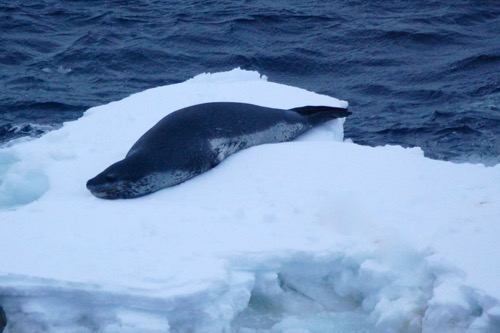Science Update
Yesterday, we collected samples from 44 incubation bottles. It was a long day of filtering, labeling and storing samples. This is day 10 of Incubation 3, so we will not be collecting samples from these bottles today. Instead, the science team will work on data entry, data analysis, individual experiments and packing samples. We will also gather for a science meeting later this afternoon to hear from our head scientists about current data trends and additional background information related to the research cruise. I enjoy these science meetings because it is an opportunity to learn more about the thought process behind certain decisions and to hear more from each member of the science team regarding their contributions.
Ice Update
Our forward progress has definitely improved in the last 12 hours. More cracks are appearing in the ice as we continue to work our way through the snow and ice. Open water is now in sight (approximately 6 miles away as of 2100 last evening). Although the process is slow, we are moving and will eventually reach open water, and our next sampling station.
Another Check on the Bucket List
From the moment I learned that I would be traveling to the Southern Ocean and the Antarctic Peninsula I had one goal - see a leopard seal. Why? First, this is the only place that you can see leopard seals (to my knowledge, they are not held in captivity) and second, they are intelligent, powerful animals that I have always found intriguing (aka they are AWESOME!). From the moment I boarded this ship, I made it known that I wanted to see a leopard seal. A standing order was in place with everyone aboard to notify me if there was a leopard seal sighting. Earlier this week, I got a knock on my cabin door followed by four words: leopard seal, starboard side. Music to my ears!! I took about 50 pictures of this one seal and spent the rest of the time simply watching this impressive animal. Another truly amazing experience in Antarctica!
Leopard Seals Hydrurga leptonyx
Leopard seals, along with the orca (or killer whale) are considered to be the top predators in the Antarctic ecosystem. As adults, leopard seals primarily eat penguins, but have also been known to feed on krill and other species of seals. These carnivores have long fore-flippers and powerful back and shoulder muscles that allow for speed and agility while chasing penguins below the surface of the water, or on ice. Leopard seals (also known as sea leopards) have long (2.5cm/1inch) canine teeth at the front of their mouth to aid in their attacks. The molars near the back of the mouth, while sharp enough for chewing and tearing, are able to interlock like the teeth of the crabeater seal in order to strain krill from the water. It is thought that younger leopard seals may rely on krill for food earlier in life before they master their hunting techniques.
Another interesting adaptation for the leopard seal is referred to as counter-shading. This coloration pattern is a common form of camouflage in the animal world. In counter-shading, the dorsal (top) portion of the body is dark while the ventral (bottom) portion of the body is lighter in color. This is true for both predator and prey animals.

In the image above, there is a noticeable color difference between the dorsal side (back) and the color of the (ventral side) belly of the seal. If the leopard seal is swimming below a penguin or group of penguins, the dark coloration of the dorsal surface blends in with the darker waters at depth. If the leopard seal is swimming above its prey, the lighter ventral surface mimics the lighter areas in the surface of the water, especially if the sun is shining. This counter-shading may provide additional time for predators to stalk their prey, or for prey to escape before the predator takes notice.
Leopard Seal Facts:
- Length: ~8.5-12ft (females are slightly larger than males)
- Weight: 500-1400lbs
- Named for coloration on throat: mostly white area with black spots
- Breeding season: November to January (single pups are born in May or June)
- Large, reptilian head (distinct shape from other seals in area) with v-shaped nostrils that appear to point upward instead of forward like other seals in the area
- Can be detected underwater using a hydrophone (underwater microphone) because of the distinct trills and moans that are produced by leopard seals. Males actually produce distinct, individual 'songs' during the breeding season.
- Usually solitary (do not form groups)


As we watched this leopard seal, it remained on the ice floe for a long period of time before moving into the water. The seal did not make any attempts to vocalize at the ship and it did not show any aggression towards the vessel. There are many stories of leopard seals behaving in a aggressive manner towards large ships (even those as large the RVIB Palmer)! Other stories include leopard seals hunting penguins, or swimming along the edge of the ice looking for food. There are other stories that show another side to leopard seals - including behaviors interpreted as teaching. Science team member Dr. Randie Bundy enjoyed the leopard seal story in the TED talk by Paul Nicklen entitled: Animal Tales from Icy Wonderlands. Check it out - you won't regret it!
Love From Little Landlubbers
Speaking of wildlife - I have a few penguin pictures to share. The drawings were made by Asha and Eric from Chicago, IL. Thank you both!




Comments